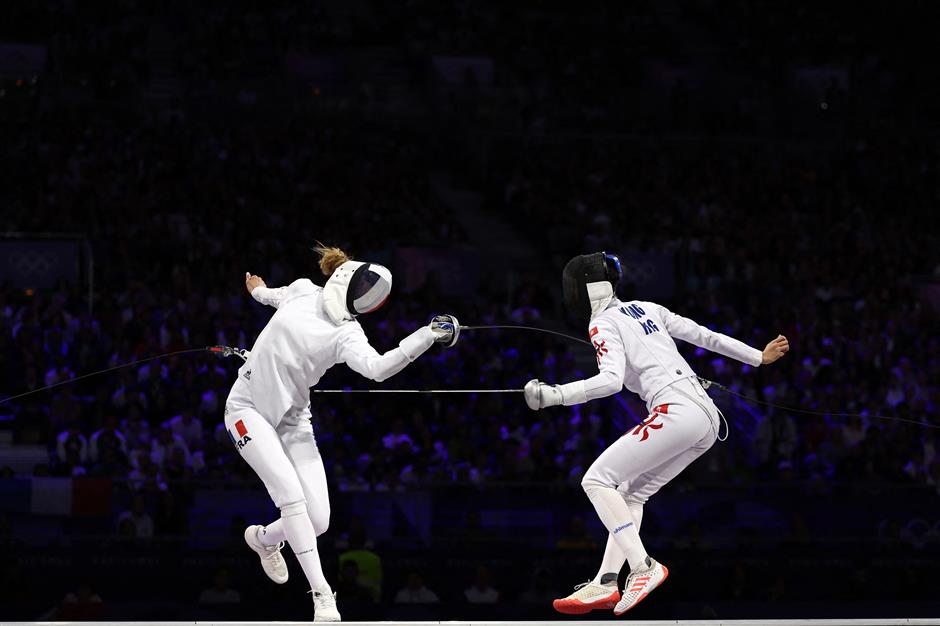As a globally anticipated sporting event, the 2024 Paris Olympics not only showcases the allure of sports but also provides a unique marketing platform for brands. The influence of the Olympics extends beyond athletics, presenting prime opportunities for brand marketing.
This trend is exemplified by ‘A-Tiao Jie’ Huang Yuting’s hairpins becoming a retail hit, Quan Hongchan’s ‘ugly slippers’ going viral, Zheng Qinwen’s victory enhancing brand visibility, and most recently, Cheung Ka Long’s Van Cleef & Arpels bracelet capturing the attention of Chinese expats. These instances highlight how athlete-driven trends can amplify brand impact far beyond the sporting arena, opening new avenues for brand marketing.

Photo: Getty Images
This article delves into the marketing strategies for the 2024 Paris Olympics in China. We will examine the impact of social media, analyze successful cases, and provide actionable marketing advice for brands.
Olympic Topics Trigger Nationwide Attention with Explosive Growth
According to the “2024 Paris Olympics Heat Trend Insights” report by ENDATA Marketing Think Tank, the buzz surrounding the “Paris Olympics” on social platforms has been steadily rising since the opening ceremony was confirmed in March. The heat peaked with the official launch of the opening ceremony in July. In the first half of 2024, the number of related social media posts reached 199,000, a 2,190% increase year-on-year. Over the past year, engagement metrics of the related posts surged to 170 million, up 2,853%. engagement.

On platforms like Xiaohongshu (RED) and Douyin (TikTok), for instance, topics related to the “Paris Olympics” have topped the popular topic trends. ENDATA’s data from January to July 2024, compared to data from December 2023 to July 2024, shows significant difference on commercial content in Xiaohongshu and Douyin.
On Xiaohongshu, commercial content volume increased by 1,080%, with engagement growing by 2,878%. On Douyin, commercial content volume surged by 2,524%, and engagement rose by 1,970%. Additionally, regarding advertising placements and KOL (Key Opinion Leader) partnerships, Xiaohongshu saw a dramatic 5,706% rise in commercial investment and a 1,013% increase in KOL collaborations. Meanwhile, Douyin experienced an 1,808% increase in commercial investment and a 2,440% rise in KOL numbers.

Data source from ENDATA
According to EternityX’s search trends, audience focus points are mainly on the following:
- Athlete Popularity: Chinese athletes like Chen Meng, Wang Manyu, and Gu Ailing have become hot searches.
- Event Attention: Traditional dominant sports like table tennis and badminton remain popular, while nascent events like skateboarding and climbing are also gaining traction.
- Event Viewing Demand: Searches for live streaming and tickets are surging.

Data source from ENDATA
In addition, some previously lesser-known niche sports are now receiving unprecedented attention. Sports like climbing, skateboarding, and surfing are seeing impressive interactions and discussion levels on platforms like Xiaohongshu and Douyin. This trend not only reflects the diversification of public interest, but also creates new marketing avenues for brands.
Savvy brands have started to engage with these emerging sports: Xtep started to sponsor the Chinese breakdancing national team in 2021; FILA FUSION partnered with the Chinese skateboarding team in 2023 to launch a co-branded product line; FILA secured sponsorship rights for the Chinese archery team and the Hong Kong delegation; JD became the chief strategic partner of the Chinese national fencing team.
In parallel, Hong Kong athletes are forging strong ties with global brands. Dior Men has deepened its relationship with two-time Olympic fencing champion Cheung Ka Long, who has been its Hong Kong ambassador since his 2021 Tokyo triumph. Chanel and Arena are proudly collaborating with swimming medalist Siobhan Haughey, while RIMOWA recently spotlighted Vivian Kong, Hong Kong’s first gold medalist at the Paris Olympics, in a new campaign. Vivian is also an Adidas athlete—a brand with which she shares a unique story. Despite Adidas discontinuing their fencing shoes years ago, a dedicated Hong Kong employee scoured the globe to secure the last remaining pairs in her size. It was in one of these pairs that Vivian made history, clinching her Olympic gold.

Photo: AFP
How Data-Driven Olympic Marketing Can Stand Out
For brands, the Olympics undoubtedly offer a unique opportunity to boost brand awareness and influence. With appropriate strategies and innovative approaches, even brands with limited budgets can stand out.
On one hand, brands should leverage various Chinese social media platforms such as Xiaohongshu, Douyin, and WeChat, and engage in trending discussions. User behavior and platform ecosystems differ from platform to platform: Xiaohongshu has shown significant growth in content engagement, while Douyin has seen faster growth in commercial contents and KOL partnerships. Understanding the dynamics of each platform allows brands to tailor their multichannel marketing strategies, creating targeted content and advertising placement plans for maximum impact.

On the other hand, search data offers valuable marketing materials and entry points for brands, as it reveals consumer interests in the Olympics: attention to athletes, demand for live streaming, interest in Olympic culture, and enthusiasm for related merchandise. Brands can boost user engagement by partnering with nano and micro KOCs/KOLs who align with their brand. These partnerships can create relevant topics and social media challenges that resonate with the Olympic spirit. Working with KOCs/KOLs focused on emerging or niche Olympic sports can further expand brand influence.
Additionally, data-driven programmatic advertising enables small brands to target their audiences more precisely, delivering relevant ads based on users’ Olympic interests and viewing behaviors.

Successful Olympic marketing requires brands to deeply understand Chinese consumer preferences and market trends. With the assistance of professional marketing firms, brands can better grasp the nuances of the Chinese market and create targeted strategies.
Whether focusing on traditional dominant sports or emerging niche sports, significant marketing potential exists. On this stage where sports intersect with brands, tradition meets innovation, and global trends blend with local interests, those who identify opportunities early will capture business prospects in the Chinese market.



